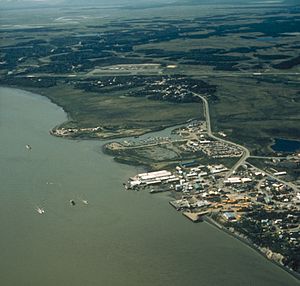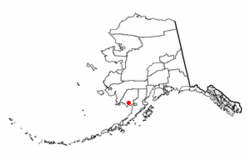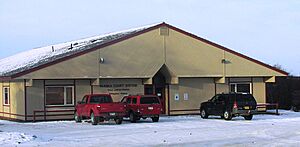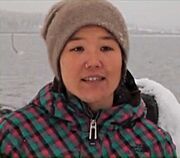Dillingham, Alaska facts for kids
Quick facts for kids
Dillingham, Alaska
Curyung
|
|
|---|---|

Aerial view of Dillingham
|
|

Location of Dillingham, Alaska
|
|
| Country | United States |
| State | Alaska |
| Census Area | Dillingham |
| Incorporated | July 12, 1963 |
| Area | |
| • Total | 36.07 sq mi (93.41 km2) |
| • Land | 33.34 sq mi (86.35 km2) |
| • Water | 2.73 sq mi (7.06 km2) |
| Elevation | 95 ft (29 m) |
| Population
(2020)
|
|
| • Total | 2,249 |
| • Density | 67.45/sq mi (26.04/km2) |
| Time zone | UTC-9 (Alaska (AKST)) |
| • Summer (DST) | UTC-8 (AKDT) |
| ZIP code |
99576
|
| Area code | 907 |
| FIPS code | 02-18950 |
| GNIS feature ID | 1401203 |
Dillingham (also known as Curyung) is a city in Dillingham Census Area, Alaska, United States. It was officially made a city in 1963. Dillingham is a very important place for commercial fishing on Nushagak Bay. In 2020, about 2,249 people lived there.
Contents
Where is Dillingham Located?
Dillingham is found on Nushagak Bay, which is where the Nushagak River meets the sea. This bay is part of Bristol Bay, which is an arm of the Bering Sea in southwestern Alaska. The city covers about 94.1 square kilometers (36.3 square miles). Most of this area is land, but about 7.2 square kilometers (2.8 square miles) is water.
Dillingham is part of the 37th district in the Alaska House of Representatives. It is represented by Bryce Edgmon, who is an Independent politician.
How to Get Around Dillingham
Dillingham is not connected to Alaska's main road system. This means you can only reach the city by airplane or boat. The Dillingham Airport is close to the city center. It has a long runway and offers daily flights. You can fly with Alaska Airlines (in summer) and PenAir (all year).
There is a 20-mile (32 km) paved road that connects Dillingham to Aleknagik. This road also leads to the Wood-Tikchik State Park. Many people live along this road and other roads that connect to the city's main area.
What Natural Resources Does Dillingham Have?
Dillingham is a key area for the rich Bristol Bay salmon fishing district. Bristol Bay has the world's largest runs of wild sockeye salmon. It also has other types of Pacific salmon. The Nushagak district catches millions of salmon every year. The Alaska Department of Fish and Game carefully watches these catches. This helps make sure there are enough salmon for the future. It also allows local people to catch fish for their own use.
Commercial fishing is a very important part of Dillingham's economy. The price of salmon can change due to competition from other countries. These countries often have fish farming operations. In 2013, the price for fresh sockeye salmon was $2.35 per pound. By 2016, it went up to $3.02 per pound.
Dillingham is also a great place for sport fishing and eco-tourism. Many people visit the nearby Wood-Tikchik State Park. This is the largest state park in the United States and is known for its amazing fishing. Dillingham is also home to the headquarters for the Togiak National Wildlife Refuge. This refuge protects many animals, including walruses, seals, birds, and fish. It also has one of the world's largest wild herring fisheries.
In 2010, the people of Dillingham voted against the proposed Pebble Mine. This was a large gold and copper mining project. The city said that the fishing industry is worth about $100 million a year. They also said that the future of their natural resources depends on clean freshwater streams. The mine would threaten the last great wild salmon fishery on Earth.
Who Lives in Dillingham?
| Historical population | |||
|---|---|---|---|
| Census | Pop. | %± | |
| 1910 | 165 | — | |
| 1920 | 182 | 10.3% | |
| 1930 | 85 | −53.3% | |
| 1940 | 278 | 227.1% | |
| 1950 | 577 | 107.6% | |
| 1960 | 424 | −26.5% | |
| 1970 | 914 | 115.6% | |
| 1980 | 1,563 | 71.0% | |
| 1990 | 2,017 | 29.0% | |
| 2000 | 2,466 | 22.3% | |
| 2010 | 2,329 | −5.6% | |
| 2020 | 2,249 | −3.4% | |
| U.S. Decennial Census | |||
Dillingham first appeared in the U.S. Census in 1910. It was called Kanakanak back then. In 1963, it officially became a city.
In 2000, there were 2,466 people living in Dillingham. About 52.6% of the people were Native American. Around 35.6% were White. The rest were from other racial backgrounds. About 34.6% of the population was under 18 years old. The average age in the city was 33 years.
History of Dillingham
The area where Dillingham is now has been home to the Yup'ik for thousands of years. In 1778, British Captain James Cook explored the Bristol Bay area. In 1818, the Russian-American Company built a trading post called "Alexandrovski" near Dillingham. This post attracted fur traders from far away. A Russian Orthodox church was built there in 1837.
After the Alaska Purchase by the United States, a weather station was built in 1881.
The first salmon cannery in Bristol Bay was built in 1883. By 1903, ten canneries were built along the Nushagak River. Four of these were within what is now Dillingham. They produced millions of cans of salmon each year. Many of these canneries later closed.
In 1901, the Alaska-Portland Packers Association built a cannery near Snag Point. This is now the main part of Dillingham. This cannery is now called Peter Pan Seafoods and is still working today.
A courthouse was built in Kanakanak in 1903. It was named after United States Senator William Paul Dillingham. The post office and the community later took this name.
In 1918 and 1919, the global Spanish influenza pandemic hit Bristol Bay. Only about 500 people survived around Dillingham. A hospital was built in Kanakanak after this. Today, an Indian Health Service hospital is still there.
In 1947, the first local newspaper, the Dillingham News, was published. In 1951, fishermen in Bristol Bay were allowed to use powerboats instead of sailboats. The City of Dillingham officially became a city in 1963.
In 1974, the first regional radio station, KDLG, was built in Dillingham. It provides news, entertainment, and safety information. It is part of the National Public Radio (NPR) network.
Today, the main industries in Dillingham are commercial salmon and herring fishing, seafood processing, sport fishing, government jobs, and tourism.
In 2006, Dillingham got national attention. The city put 80 cameras in city-owned places like the dock and police station. These cameras were paid for by a government grant. Some people thought this was an invasion of privacy. The community voted on the system, and decided to keep the cameras.
In 2010, a plane crashed near Dillingham. Former Senator Ted Stevens was one of the five people who died. In 2015, President Obama visited Dillingham. He came to talk about climate change.
Understanding Dillingham's Place Names
Over time, the names of places around Dillingham have changed and caused some confusion.
- In 1880, the village of Anagnak was recorded.
- In 1890, two villages, Bradford and Kanakanak, were reported.
- By 1900, a "new" Kanakanak was reported where Bradford used to be.
- In 1910, a different Kanakanak was reported at Snag Point, also known as "Chogiung." The Dillingham Post Office opened here.
- In 1920, Chogiung and Dillingham were reported. The flu pandemic caused many people to move around.
- In 1930, Dillingham, Kanakanak, and Wood River were listed.
- By 1950, Dillingham and Kanakanak were still reported, but Kanakanak's population had dropped a lot.
- Since 1960, Dillingham has been the only community reported in the census for this area.
Today, Anagnak (or Wood Point) and Bradford Point are within Dillingham's city limits. The current downtown Dillingham was once called Kanakanak (the 3rd village) or Chogiung. Only the original "Old" Kanakanak is outside the current city boundaries, south of the Kanakanak Hospital.
Education in Dillingham
The University of Alaska Fairbanks Bristol Bay Campus (BBC) is located in Dillingham. It is one of five rural campuses in Alaska. The campus serves a large area with 32 communities. BBC offers different degrees and courses. These courses cover many subjects, from computers to art. The Bristol Bay Campus also has a Sea Grant Marine Advisory Program.
The Dillingham City School District runs two public schools in Dillingham:
- Dillingham Elementary School
- Dillingham Middle/High School
The Southwest Region School District has its main office in Dillingham. This district serves other communities in the Dillingham Census Area. There is also a K-12 school run by the Seventh Day Adventist Church in Dillingham.
Climate in Dillingham
Dillingham has a typical subarctic climate. This means it has mild and rainy summers with cool nights. The winters are long, cold, and get a lot of snow.
| Climate data for Dillingham (1981–2010 normals, extremes 1919–2001) | |||||||||||||
|---|---|---|---|---|---|---|---|---|---|---|---|---|---|
| Month | Jan | Feb | Mar | Apr | May | Jun | Jul | Aug | Sep | Oct | Nov | Dec | Year |
| Record high °F (°C) | 53 (12) |
54 (12) |
60 (16) |
63 (17) |
77 (25) |
92 (33) |
87 (31) |
81 (27) |
73 (23) |
70 (21) |
52 (11) |
51 (11) |
92 (33) |
| Mean maximum °F (°C) | 36.6 (2.6) |
37.5 (3.1) |
40.0 (4.4) |
49.2 (9.6) |
63.1 (17.3) |
70.8 (21.6) |
72.4 (22.4) |
70.5 (21.4) |
61.1 (16.2) |
51.1 (10.6) |
41.0 (5.0) |
37.0 (2.8) |
75.7 (24.3) |
| Mean daily maximum °F (°C) | 20.7 (−6.3) |
24.0 (−4.4) |
28.4 (−2.0) |
37.8 (3.2) |
50.3 (10.2) |
58.1 (14.5) |
61.2 (16.2) |
59.8 (15.4) |
52.7 (11.5) |
39.3 (4.1) |
27.5 (−2.5) |
22.6 (−5.2) |
40.2 (4.6) |
| Daily mean °F (°C) | 15.1 (−9.4) |
18.2 (−7.7) |
22.3 (−5.4) |
31.6 (−0.2) |
43.3 (6.3) |
51.2 (10.7) |
55.1 (12.8) |
53.6 (12.0) |
46.8 (8.2) |
33.4 (0.8) |
22.2 (−5.4) |
17.1 (−8.3) |
34.2 (1.2) |
| Mean daily minimum °F (°C) | 9.5 (−12.5) |
12.5 (−10.8) |
16.3 (−8.7) |
26.5 (−3.1) |
36.4 (2.4) |
44.4 (6.9) |
49.0 (9.4) |
47.4 (8.6) |
40.0 (4.4) |
27.6 (−2.4) |
16.9 (−8.4) |
11.6 (−11.3) |
28.2 (−2.1) |
| Mean minimum °F (°C) | −18.7 (−28.2) |
−15.7 (−26.5) |
−4.9 (−20.5) |
8.5 (−13.1) |
26.5 (−3.1) |
36.4 (2.4) |
42.1 (5.6) |
37.1 (2.8) |
28.5 (−1.9) |
9.8 (−12.3) |
−4.5 (−20.3) |
−12.4 (−24.7) |
−25.5 (−31.9) |
| Record low °F (°C) | −53 (−47) |
−35 (−37) |
−30 (−34) |
−17 (−27) |
10 (−12) |
26 (−3) |
31 (−1) |
26 (−3) |
11 (−12) |
0 (−18) |
−26 (−32) |
−30 (−34) |
−53 (−47) |
| Average precipitation inches (mm) | 1.74 (44) |
1.12 (28) |
1.66 (42) |
0.88 (22) |
1.25 (32) |
2.04 (52) |
2.64 (67) |
3.84 (98) |
3.62 (92) |
2.40 (61) |
2.34 (59) |
1.79 (45) |
25.32 (643) |
| Average snowfall inches (cm) | 22.8 (58) |
9.8 (25) |
14.7 (37) |
4.7 (12) |
0.3 (0.76) |
0.0 (0.0) |
0.0 (0.0) |
0.0 (0.0) |
0.1 (0.25) |
3.1 (7.9) |
17.5 (44) |
17.9 (45) |
90.9 (231) |
| Average precipitation days (≥ 0.01 inch) | 10.7 | 7.4 | 8.5 | 7.8 | 11.3 | 13.9 | 14.0 | 15.9 | 16.1 | 10.9 | 12.4 | 11.9 | 140.8 |
| Average snowy days (≥ 0.1 inch) | 8.6 | 5.3 | 6.8 | 3.2 | 0.3 | 0.0 | 0.0 | 0.0 | 0.1 | 2.1 | 7.0 | 8.4 | 41.8 |
| Source 1: NOAA | |||||||||||||
| Source 2: XMACIS2 (mean maxima/minima 1981–2010), | |||||||||||||
Famous People from Dillingham
- Callan Chythlook-Sifsof (born 1989), an Olympic snowboarder.
- Bryce Edgmon (born 1961), a member of the Alaska House of Representatives.
- Todd Palin (born 1964), a businessman who was the First Gentleman of Alaska from 2006 to 2009.
See also
 In Spanish: Dillingham para niños
In Spanish: Dillingham para niños



